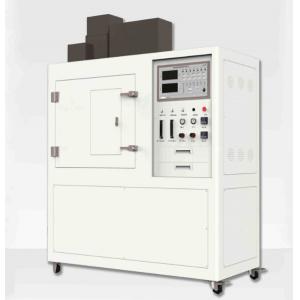ISO 5659 NBS Plastic Flammability Smoke Density Performance Testing
Equipment
Product Description:
- The test equipment is suitable for determining the specific
optical density of the smoke generated when the plastic is burned,
and the maximum specific optical density is the test result. It is
used to assess the smoking performance of plastics under specified
conditions.
- This instrument is suitable for all plastics, but also for the
evaluation of other materials (such as rubber, textile coverings,
painted surfaces, wood and other materials). It is widely used by
the plastics industry, solid-materials manufacturing plants, and
research and experimental units.
Standard:
- GB/8323.2-2008
- ISO 5659-2:Test methods for the determination of smoke density
using the single chamber method for the production of plastic
cigarettes
- Astm e662
Technical Parameters:
The entire instrument consists of a sealed chamber, a photometric
measuring system, a radiation cone, a combustion system, an
igniter, a test box, a bracket, a temperature measuring instrument,
and a smoke density test software. The circuit is developed using a
single-chip microcomputer and has high technical content and stable
performance.
1.1 The front door is fitted with windows and opaque shutters that
block the movement of the windows.
1.2 The bottom of the square box is fitted with a bursting aluminum
foil for preventing overpressure. The bursting disc consists of a
safety bursting disc with a thickness of 0.04mm, a length of 405mm
and a width of 200mm and a total area of 81000mm2. The pressure
regulating device inside the box is installed (see Figure 2). ).
1.3 Light window: Up and down two Ø75mm light windows, with a 9W
annular electric heater under the light window to ensure the
temperature of the upper surface of the light window (50oC ~ 55oC
is appropriate) to reduce the smoke concentration on the surface.
To the minimum, the window is on the top of the test box. An 8mm
thick optical platform is installed around the light window outside
the test box. The optical platform is fixed with a Ø15mm metal bar
that can connect the fixed platform and the test box.
1.4 inside size: high 914mmX width 914mmX deep 610mm
2. the photoelectric measurement system: from the power supply, photomultiplier tube, amplified
translucent film, optical shutter, filter, neutral transparent
sheet, lens, optical system, camera, light source, light window
heater
2.1, light source:
2.1.1, light source: consists of an incandescent lamp of 6.5V, a
transformer for power supply (input 220V output 6.5V), and a
variable resistor.
2.1.2 Installation: The light bulb is installed in the opaque dark
box at the bottom of the test box and consists of a light source, a
convex lens, an optical window heater, and an optical window.
2.1.3. Light window adder: AC220V power supply, 9W resistance wire
is wrapped around to ensure that the temperature of the upper
surface of the light window (50 oC ~ 55oC) is appropriate.
2.1.4, Convex Lens: The diameter of 51mm, adjusted and calibrated
to completely form a ring with a diameter of 51mm and no other
light outside the ring.
2.1.5, optical window: consists of unobstructed light transmissive
film and dark box.
2.2, photoelectric detector:
2.2.1 Photodetector: It consists of photomultiplier tube,
amplification filter, shutter, filter, neutral filter, convex lens,
optical window and so on.
2.2.2 Photomultiplier tube:
2.2.3. Amplify the filter: The light transmittance of ND-2.0 is
0.95% and the temperature of the A light source is K=2854.
2.2.4, light gate: for the baffle, corrected light transmittance 0%
use.
2.2.5, filter: To compensate the filter, the optical density of 0.1
~ 1.0 and 2.0 a total of 11 pieces.
2.2.6, neutral filter: ND-0.5, light transmittance 31.7%, A light
source color temperature K = 2854.
2.2.7, Convex Lens: A diameter of 51mm enables the direct beam to
be focused to a small, intense spot at the translucent plate
between the upper and lower camera boxes.
2.2.7. Calibration of the optical system: A neutral filter with an
optical density of 3.0 and a wavelength of 550-650 nm is used.
2.2.8, optical window: consists of unobstructed light transmissive
film and dark box.
3. radiation cone:
3.1, radiation cone: composed of heating elements with a rated
power of 2600W, can provide 10KW/m2~50KW/m2 radiation intensity in
the center of the sample surface. When measuring the irradiance at
two other locations 25 mm from the center of the sample, the
irradiance at these two locations must not be less than 85% of the
irradiance at the center of the sample.
3.2 Radiant Cone Heater: It is powered by an independent power
supply. The power of the single-phase isolation transformer is
3000W. The temperature control is controlled by a rapid-cycle
thyristor, and the control temperature can be stabilized at ±2°C.
3.3, heat flow meter: Measuring range is 50kw/m2, receiving a
radiation area of flat area of 10mm diameter, the surface coated
with matte black, using water cooling.
3.4. Igniter: The igniter nozzle is made of Φ4.0mm aperture copper
tube, flame length, level measurement is 30mm.
4, gas supply system:
4.1, gas source: 95% purity, propane and air mixture, pressure
170Kpa
4.2, propane flowmeter: 1~100cm3/min
4.3, air flow meter: 5~500cm3/min
5. the whole performance:
5.1. light transmittance resolution: 0.0001%;
5.2. Measurement range: 0-100%; Automatic shifting when measuring.
5.3. measurement accuracy: ± 3%;
5.4. the working voltage: AC200-240V 50Hz;
5.5. ambient humidity: room temperature -40 °C
5.6. Work environment: When the instrument is running, direct light
should be avoided and there should be no forced air flow.
6, measurement software: Based on WINDOWS XP operating interface,
LabVIEW style. Displays the transmittance and time curves. Chinese
and English interface, and provide instruction manuals in English.


